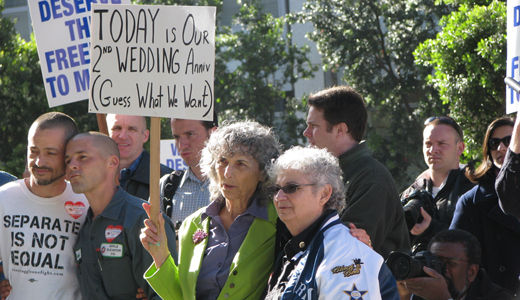
Another milestone was crossed March 26 in Californians’ years-long quest for marriage equality, as the U.S. Supreme Court considered two couples’ challenge to the state’s Prop. 8, which bars same-sex marriage.
The court is expected to announce its decision on the California case, and on a separately-heard case involving the federal Defense of Marriage Act, in June.
Issues during nearly an hour and a half of arguments included whether Prop. 8’s defenders have standing to appeal a lower court’s decision striking down the measure, passed by voters in 2008. California officials had earlier declined to defend Prop. 8, leaving appeals up to the proposition’s initiators.
Some justices referred to the speed with which the marriage equality issue has emerged, with Justice Samuel Alito Jr. calling the issue “newer than cell phones or the Internet,” and Justice Anthony Kennedy citing “five years of information to weigh against 2,000 years of history or more.”
Obama appointee Justice Sonia Sotomayor also questioned the timing of the case.
But Kennedy – regarded as the “swing vote” in cases decided by 5-4 votes – also spoke movingly of the situation of children of same-sex couples, noting that the 40,000 California children of same-sex couples want their parents to have full recognition and full status. “The voice of those children is important in this case,” he said.
An exchange that drew laughter from those in attendance concerned whether same-sex marriage would harm couples in traditional relationships. Prop. 8’s defender, Attorney Charles Cooper, admitted the government couldn’t bar couples who can’t have children, including those over 55, from marrying, but contended that even then, “it is very rare that both parties … are infertile.”
That drew Justice Elena Kagan’s response that when both are over 55, “there are not a lot of children coming out of that marriage,” as well as some joking references to former Senator Strom Thurmond’s fathering of children in his 70s.
Theodore Olson, who represented the two couples challenging Prop. 8, emphasized that the measure bars same-sex couples “from the most important relation in life,” stigmatizing a class of Californians by calling their “most cherished relationships” second-rate and unequal.
If the Supreme Court justices decide the appeal has no standing, or that the court should not have taken up the issue in the first place, same-sex marriage would become legal in California.
California Attorney General Kamala Harris said after the hearing, “The Supreme Court has described marriage as a fundamental right 14 times since 1888. The time has come for this right to be afforded to every citizen.”
Rea Carey, executive director of the National Gay and Lesbian Task Force, called on the court “to stand for all families, to stand for fairness, and to stand on the right side of history,” and strike down Prop. 8 and the Defense of Marriage Act “once and for all.”
In May 2008, the California Supreme Court overturned an earlier state ballot proposition barring same-sex marriage.
That November, voters approved Prop. 8.
Prop. 8 was then challenged by Kristin Perry and Sandy Stier of Berkeley and Paul Katami and Jeff Zarrillo of Burbank, the plaintiffs in the current case, which reached the U.S. Supreme Court after a series of lower court rulings.
Same-sex marriage is currently legal in nine states and the District of Columbia. Thirty states ban same-sex marriage in their constitutions and ten do so by state law. Only New Mexico has no state law on the issue.
Polls have shown that support for marriage equality is growing rapidly, with a mid-March Pew Research Center poll showing 49 percent of U.S. respondents in favor and 44 percent opposed.
Photo: June 2010 demonstration for marriage equality in San Francisco. Marilyn Bechtel/PW

MOST POPULAR TODAY

High Court essentially bans demonstrations, freedom of assembly in Deep South

UN warns that Israel is still blocking humanitarian aid to Gaza

Resource wars rage in eastern Congo, but U.S. capitalism only sees investment opportunity

U.S. imperialism’s ‘ironclad’ support for Israel increases fascist danger at home







Comments